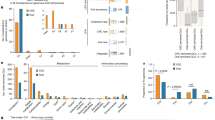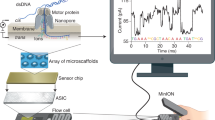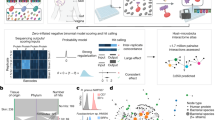Abstract
Bacteroides thetaiotaomicron is a human-associated bacterium that holds promise for delivery of therapies in the gut microbiome1. Therapeutic bacteria would benefit from the ability to turn on different programs of gene expression in response to conditions inside and outside of the gut; however, the availability of regulatory parts, and methods to combine them, have been limited in B. thetaiotaomicron2,3,4,5. We report implementation of Cello circuit design automation software6 for this species. First, we characterize a set of genome-integrated NOT/NOR gates based on single guide RNAs (CRISPR–dCas9) to inform a Bt user constraint file (UCF) for Cello. Then, logic circuits are designed to integrate sensors that respond to bile acid and anhydrotetracycline (aTc), including one created to distinguish between environments associated with bioproduction, the human gut, and after release. This circuit was found to be stable under laboratory conditions for at least 12 days and to function in bacteria associated with a primary colonic epithelial monolayer in an in vitro human gut model system.
This is a preview of subscription content, access via your institution
Access options
Access Nature and 54 other Nature Portfolio journals
Get Nature+, our best-value online-access subscription
$29.99 / 30 days
cancel any time
Subscribe to this journal
Receive 12 print issues and online access
$209.00 per year
only $17.42 per issue
Buy this article
- Purchase on Springer Link
- Instant access to full article PDF
Prices may be subject to local taxes which are calculated during checkout




Similar content being viewed by others
Data availability
Genetic parts and the UCF file Bth1C1G1T1 are available as Supplementary Information. The DNA sequences for the following plasmids are deposited into GenBank: pMT405 (MN991273); pMT406 (MN991274); pMT423 (MN991275); pMT444 (MN991276); pMT445 (MN991277); pMT447 (MN991278); pMT448 (MN991279); pMT449 (MN991280); pMT450 (MN991281); pMT451 (MN991282); pMT455 (MN991283); pMT462 (MN991284); pMT468 (MN991285); pMT469 (MN991286); pMT470 (MN991287); pMT492 (MN991288); pMT493 (MN991289); pMT494 (MN991290).
Code availability
The Cello software and codes are freely available (https://github.com/CIDARLAB/cello).
Change history
07 May 2020
A Correction to this paper has been published: https://doi.org/10.1038/s41587-020-0545-9
References
Claesen, J. & Fischbach, M. A. Synthetic microbes as drug delivery systems. ACS Synth. Biol. 4, 358–364 (2015).
Mimee, M., Tucker, A. C., Voigt, C. A. & Lu, T. K. Programming a human commensal bacterium, bacteroides thetaiotaomicron, to sense and respond to stimuli in the murine gut microbiota. Cell Syst. 1, 62–71 (2015).
Lim, B., Zimmermann, M., Barry, N. A. & Goodman, A. L. Engineered regulatory systems modulate gene expression of human commensals in the gut. Cell 169, 547–558.e515 (2017).
Whitaker, W. R., Shepherd, E. S. & Sonnenburg, J. L. Tunable expression tools enable single-cell strain distinction in the gut microbiome. Cell 169, 538–546.e512 (2017).
Ruder, W. C., Lu, T. & Collins, J. J. Synthetic biology moving into the clinic. Science 333, 1248–1252 (2011).
Nielsen, A. A. et al. Genetic circuit design automation. Science 352, aac7341 (2016).
Ozdemir, T., Fedorec, A. J. H., Danino, T. & Barnes, C. P. Synthetic biology and engineered live biotherapeutics: toward increasing system complexity. Cell Syst. 7, 5–16 (2018).
Lee, J. W., Chan, C. T. Y., Slomovic, S. & Collins, J. J. Next-generation biocontainment systems for engineered organisms. Nat. Chem. Biol. 14, 530–537 (2018).
Piraner, D. I., Abedi, M. H., Moser, B. A., Lee-Gosselin, A. & Shapiro, M. G. Tunable thermal bioswitches for in vivo control of microbial therapeutics. Nat. Chem. Biol. 13, 75–80 (2017).
Isabella, V. M. et al. Development of a synthetic live bacterial therapeutic for the human metabolic disease phenylketonuria. Nat. Biotechnol. 36, 857–864 (2018).
Riglar, D. T. & Silver, P. A. Engineering bacteria for diagnostic and therapeutic applications. Nat. Rev. Microbiol. 16, 214–225 (2018).
Wexler, A. G. & Goodman, A. L. An insider’s perspective: Bacteroides as a window into the microbiome. Nat. Microbiol. 2, 17026 (2017).
Schwalm, N. D. & Groisman, E. A. Navigating the gut buffet: Control of polysaccharide utilization in bacteroides spp. Trends Microbiol. 25, 1005–1015 (2017).
Faith, J. J. et al. The long-term stability of the human gut microbiota. Science 341, 1237439 (2013).
Donaldson, G. P., Lee, S. M. & Mazmanian, S. K. Gut biogeography of the bacterial microbiota. Nat. Rev. Microbiol. 14, 20–32 (2015).
Jacobson, A. et al. A gut commensal-produced metabolite mediates colonization resistance to salmonella infection. Cell Host Microbe 24, 296–307.e297 (2018).
Russell, AlistairB. et al. A type VI secretion-related pathway in bacteroidetes mediates interbacterial antagonism. Cell Host Microbe 16, 227–236 (2014).
Ramakrishna, C. et al. Bacteroides fragilis polysaccharide A induces IL-10 secreting B and T cells that prevent viral encephalitis. Nat. Commun. 10, 2153 (2019).
Wegorzewska, M. M. et al. Diet modulates colonic T cell responses by regulating the expression of a Bacteroides thetaiotaomicron antigen. Science Immunol. 4, eaau9079 (2019).
Hamady, Z. Z. R. et al. Xylan-regulated delivery of human keratinocyte growth factor-2 to the inflamed colon by the human anaerobic commensal bacterium Bacteroides ovatus. Gut 59, 461–469 (2010).
Round, J. L. & Mazmanian, S. K. Inducible Foxp3+ regulatory T-cell development by a commensal bacterium of the intestinal microbiota. PNAS 107, 12204–12209 (2010).
Shepherd, E. S., DeLoache, W. C., Pruss, K. M., Whitaker, W. R. & Sonnenburg, J. L. An exclusive metabolic niche enables strain engraftment in the gut microbiota. Nature 557, 434–438 (2018).
Qi, LeiS. et al. Repurposing CRISPR as an RNA-guided platform for sequence-specific control of gene expression. Cell 152, 1173–1183 (2013).
Daeffler, K. N. M. et al. Engineering bacterial thiosulfate and tetrathionate sensors for detecting gut inflammation. Mol. Syst. Biol. 13, 923 (2017).
Riglar, D. T. et al. Engineered bacteria can function in the mammalian gut long-term as live diagnostics of inflammation. Nat. Biotechnol. 35, 653–658 (2017).
Archer, E. J., Robinson, A. B. & Süel, G. M. Engineered E. coli that detect and respond to gut inflammation through nitric oxide sensing. ACS Synth. Biol. 1, 451–457 (2012).
Hwang, I. Y. et al. Engineered probiotic Escherichia coli can eliminate and prevent Pseudomonas aeruginosa gut infection in animal models. Nat. Commun. 8, 1–11 (2017).
Chen, Y. et al. Robust bioengineered 3D functional human intestinal epithelium. Sci. Rep. 5, 1–11 (2015).
Leschner, S. et al. Identification of tumor-specific Salmonella Typhimurium promoters and their regulatory logic. Nucleic Acids Res. 40, 2984–2994 (2012).
Ozdemir, T. Design and construction of therapeutic bacterial sensors in Escherichia coli Nissle 1917. PhD thesis, University College London (2018).
Kotula, J. W. et al. Programmable bacteria detect and record an environmental signal in the mammalian gut. PNAS 111, 4838–4843 (2014).
Kim, S. et al. Quorum sensing can be repurposed to promote information transfer between bacteria in the mammalian gut. ACS Synth. Biol. 7, 2270–2281 (2018).
Chen, J. X. et al. Development of aspirin-inducible biosensors in Escherichia coli and SimCells. Appl. Environ. Microbiol. 85, e02959-18 (2019).
Mimee, M., Citorik, R. J. & Lu, T. K. Microbiome therapeutics - Advances and challenges. Adv. Drug Deliv. Rev. 105, 44–54 (2016).
Yao, L. et al. A selective gut bacterial bile salt hydrolase alters host metabolism. eLife 7, e37182 (2018).
Ridlon, J. M., Kang, D. J., Hylemon, P. B. & Bajaj, J. S. Bile acids and the gut microbiome. Curr. Opin. Gastroenterol. 30, 332–338 (2014).
Jason M. Ridlon, S. C. H. S. B. D.-J. K., Phillip & Hylemon, B. Consequences of bile salt biotransformations by intestinal bacteria. Gut Microbes 7, 22–39 (2016).
Degirolamo, C., Modica, S., Palasciano, G. & Moschetta, A. Bile acids and colon cancer: Solving the puzzle with nuclear receptors. Trends Mol. Med. 17, 564–572 (2011).
Kawamata, Y. et al. A G protein-coupled receptor responsive to bile acids. J. Biol. Chem. 278, 9435–9440 (2003).
Hofmann, A. F. & Hagey, L. R. Bile acids: chemistry, pathochemistry, biology, pathobiology, and therapeutics. Cell. Mol. Life Sci. 65, 2461–2483 (2008).
Hamilton, J. P. et al. Human cecal bile acids: concentration and spectrum. Am. J. Physiol. 293, G256–G263 (2007).
Li, T. & Chiang, J. Y. L. Bile acids as metabolic regulators. Curr. Opin. Gastroenterol. 31, 159–165 (2015).
Ung, K. A., Gillberg, R., Kilander, A. & Abrahamsson, H. Role of bile acids and bile acid binding agents in patients with collagenous colitis. Gut 46, 170–175 (2000).
Bernstein, H., Bernstein, C., Payne, C. M., Dvorakova, K. & Garewal, H. Bile acids as carcinogens in human gastrointestinal cancers. Mutat. Res. 589, 47–65 (2005).
Cerda-Maira, F. A., Ringelberg, C. S. & Taylor, R. K. The bile response repressor BreR regulates expression of the vibrio cholerae breAB efflux system operon. J. Bacteriol. 190, 7441–7452 (2008).
Gunn, J. S. Mechanisms of bacterial resistance and response to bile. Microbes Infect. 2, 907–913 (2000).
Lin, J. et al. Bile salts modulate expression of the CmeABC multidrug efflux pump in campylobacter jejuni. J. Bacteriol. 187, 7417–7424 (2005).
Rössger, K., Charpin-El-Hamri, G. & Fussenegger, M. Bile acid-controlled transgene expression in mammalian cells and mice. Metab. Eng. 21, 81–90 (2014).
Din, M. O. et al. Synchronized cycles of bacterial lysis for in vivo delivery. Nature 536, 81–85 (2016).
Riglar, D. T. et al. Bacterial variability in the mammalian gut captured by a single-cell synthetic oscillator. Nat. Commun. 10, 1–12 (2019).
Oberortner, E., Bhatia, S., Lindgren, E. & Densmore, D. A rule-based design specification language for synthetic biology. J. Emerg. Technol. Comput. Syst. 11, 25:21–25:19 (2014).
Kelly, J. R. et al. Measuring the activity of BioBrick promoters using an in vivo reference standard. J. Biol. Eng. 3, 4 (2009).
Hall, M. P. et al. Engineered luciferase reporter from a deep sea shrimp utilizing a novel imidazopyrazinone substrate. ACS Chem. Biol. 7, 1848–1857 (2012).
Cuthbertson, L., Ahn, SangK. & Nodwell, JustinR. Deglycosylation as a mechanism of inducible antibiotic resistance revealed using a global relational tree for one-component regulators. Chem. Biol. 20, 232–240 (2013).
Cerda-Maira, F. A., Kovacikova, G., Jude, B. A., Skorupski, K. & Taylor, R. K. Characterization of BreR interaction with the bile response promoters breAB and breR in Vibrio cholerae. J. Bacteriol. 195, 307–317 (2013).
Stanton, B. C. et al. Genomic mining of prokaryotic repressors for orthogonal logic gates. Nat. Chem. Biol. 10, 99–105 (2014).
Nielsen, A. A. K. & Voigt, C. A. Multi-input CRISPR/Cas genetic circuits that interface host regulatory networks. Mol. Syst. Biol. 10, n/a–n/a (2014).
Zhang, S. & Voigt, C. A. Engineered dCas9 with reduced toxicity in bacteria: implications for genetic circuit design. Nucl. Acids Res. 46, 11115–11125 (2018).
Gander, M. W., Vrana, J. D., Voje, W. E., Carothers, J. M. & Klavins, E. Digital logic circuits in yeast with CRISPR-dCas9 NOR gates. Nat. Commun. 8, 15459 (2017).
Liu, Y. et al. Synthesizing AND gate genetic circuits based on CRISPR-Cas9 for identification of bladder cancer cells. Nat. Commun. 5, 5393 (2014).
Chen, P.-Y., Qian, Y. & Del Vecchio, D. In 2018 IEEE Conference on Decision and Control (CDC) 4333–4338 (IEEE, 2018).
Chen, Y.-J. et al. Characterization of 582 natural and synthetic terminators and quantification of their design constraints. Nat. Meth. 10, 659–664 (2013).
Kozuka, K. et al. Development and characterization of a human and mouse intestinal epithelial cell monolayer platform. Stem Cell Rep. 9, 1976–1990 (2017).
Li, H. et al. The outer mucus layer hosts a distinct intestinal microbial niche. Nat. Commun. 6, 1–13 (2015).
Fofanova, T. Y. et al. A novel human enteroid-anaerobe co-culture system to study microbial-host interaction under physiological hypoxia. Preprint at bioRxiv https://doi.org/10.1101/555755 (2019).
Srinivasan, B. et al. TEER measurement techniques for in vitro barrier model systems. J. Lab. Autom. 20, 107–126 (2015).
Shah, P. et al. A microfluidics-based in vitro model of the gastrointestinal human–microbe interface. Nat. Commun. 7, 11535 (2016).
Jalili-Firoozinezhad, S. et al. A complex human gut microbiome cultured in an anaerobic intestine-on-a-chip. Nat. Biomed. Eng. 3, 520–531 (2019).
Roper, J. et al. In vivo genome editing and organoid transplantation models of colorectal cancer and metastasis. Nat. Biotechnol. 35, 569–576 (2017).
Acknowledgements
We thank M. Mimee (MIT) and T. Lu (MIT) for providing us with the NBU1-based Bacteroides shuttle vector pNBU1-Erm. We thank M. Fischbach (Stanford University) for providing us with the NBU2-based Bacteroides shuttle vector pNBU2-tetQ. Primary human colonic epithelial cells were obtained by generous contributions from the laboratory of O. Yilmaz (MIT). We thank K. Schneider (MIT) and C. Wright (MIT) for technical assistance. This work was supported by the National Institute of Health P50 grant (P50-GM098792), Office of Naval Research Multidisciplinary University Research Initiatives Program (N00014-13-1-0074), Defense Agency Research Projects Agency Synergistic Discovery and Design (SD2; FA8750-17-C-0229), National Science Foundation Semiconductor Synthetic Biology for Information Processing and Storage Technologies (SemiSynBio; CCF-1807575) program and National Institutes of Health (NIH R01EB021908).
Author information
Authors and Affiliations
Contributions
M.T. and C.A.V. conceived the project and designed experiments. J.Z., Y.H. and L.G. built the in vitro gut model system. M.T., A.T., J.Z. and Y.H. performed the experiments. S.Z. performed the computational work. M.T., S.Z., J.Z. and C.A.V. wrote the manuscript.
Corresponding author
Ethics declarations
Competing interests
C.A.V. and M.T. have filed a provisional patent based on this work. All other authors have no competing interests.
Additional information
Publisher’s note Springer Nature remains neutral with regard to jurisdictional claims in published maps and institutional affiliations.
Supplementary information
Supplementary Materials
Supplementary Figures 1–24, Supplementary Tables 1–6, and Supplementary File 1
Rights and permissions
About this article
Cite this article
Taketani, M., Zhang, J., Zhang, S. et al. Genetic circuit design automation for the gut resident species Bacteroides thetaiotaomicron. Nat Biotechnol 38, 962–969 (2020). https://doi.org/10.1038/s41587-020-0468-5
Received:
Accepted:
Published:
Issue Date:
DOI: https://doi.org/10.1038/s41587-020-0468-5
This article is cited by
-
Engineering intelligent chassis cells via recombinase-based MEMORY circuits
Nature Communications (2024)
-
An immune-competent human gut microphysiological system enables inflammation-modulation by Faecalibacterium prausnitzii
npj Biofilms and Microbiomes (2024)
-
Cas9-assisted biological containment of a genetically engineered human commensal bacterium and genetic elements
Nature Communications (2024)
-
Next generation synthetic memory via intercepting recombinase function
Nature Communications (2023)
-
Customizing cellular signal processing by synthetic multi-level regulatory circuits
Nature Communications (2023)



